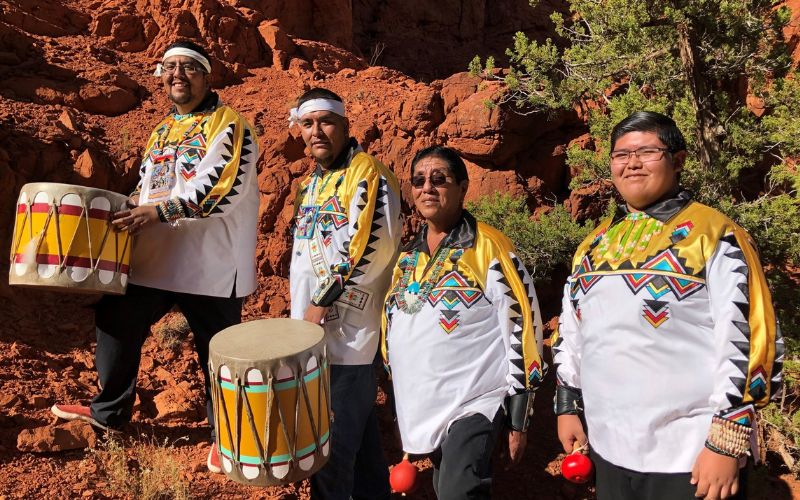
- Details
- By Native News Online Staff
Three musical albums by the Cloud Eagle Seasonal Dance Group from the Pueblos of Jemez and Zuni are now available for licensing across various media platforms including film, television, advertising, and digital content.
The group partnered with global music and SFX licensing company ALIBI Music to add their work to its expansive library. ALIBI Music's catalog has more than 400,000 audio files in its library and works with more than 400 composers and artists in 23 countries. ALIBI COO Jeffrey Parks said in a press release that the partnership with the Cloud Eagle Seasonal Dance Group is a result of clients' requesting authentic Native American music.
“With this release, ALIBI is responding to our clients’ requests for authentic music created and performed by Native Americans,” Parks said. “We are honored to present this work and will continue to offer opportunities for Native American artists to create and publish original work in native languages for use by other creators in film, television, streaming, marketing, video games and other forms of creativity exploding online.”
Formed in 1990 by four members of the Toya family, Cloud Eagle Seasonal Dance Group aims to promote their culture and language across generations. When COVID-19 halted their live performances, the group adapted by embracing digital platforms, allowing them to engage with younger audiences and extend their reach beyond their local community.
Cloud Eagle’s digital presence has not only attracted their own tribal members but also resonated with Native Americans across the continent. The opportunity to have their music featured in film and television has marked a significant milestone for the group.
“Well, this is totally on a different level -- now we're talking about film and television,” Cloud Eagle member Glendon Toya said in a press release. “…to have our music available for use in film and television excites us. We will continue this and hope and pray it reaches out to many more abroad. It also motivates us to keep inspiring our children to do more or to follow their dreams, whether it be singing, dancing... Keep praying and keep our language alive.”
The Cloud Eagle collection incorporates solid pounding percussion, flutes, and natural elements such as rumbling thunder and bird songs. The music also features rattles, powwow drums, and lyrical vocals in the native language of Towa, Zuni, Keres, and Hopi.
The albums available for licensing include "Native American 1: Cloud Eagle Pueblo Music" with 20 tracks, "Native American 2: Cloud Eagle Pueblo Music" with 12 tracks, and "Native American 3: Cloud Eagle Pueblo Music" with 12 tracks.
More Stories Like This
Zuni Youth Enrichment Project Takes Top Emerging Artist Apprentices to Phoenix for Artistic Exploration and Cultural ImmersionFrom Dishwasher to Award-Winning Chef: Laguna Pueblo's Josh Aragon Serves Up Albuquerque's Best Green Chile Stew
Rob Reiner's Final Work as Producer Appears to Address MMIP Crisis
Vision Maker Media Honors MacDonald Siblings With 2025 Frank Blythe Award
First Tribally Owned Gallery in Tulsa Debuts ‘Mvskokvlke: Road of Strength’
Help us defend tribal sovereignty.
At Native News Online, our mission is rooted in telling the stories that strengthen sovereignty and uplift Indigenous voices — not just at year’s end, but every single day.
Because of your generosity last year, we were able to keep our reporters on the ground in tribal communities, at national gatherings and in the halls of Congress — covering the issues that matter most to Indian Country: sovereignty, culture, education, health and economic opportunity.
That support sustained us through a tough year in 2025. Now, as we look to the year ahead, we need your help right now to ensure warrior journalism remains strong — reporting that defends tribal sovereignty, amplifies Native truth, and holds power accountable.
 The stakes couldn't be higher. Your support keeps Native voices heard, Native stories told and Native sovereignty defended.
The stakes couldn't be higher. Your support keeps Native voices heard, Native stories told and Native sovereignty defended.
Stand with Warrior Journalism today.
Levi Rickert (Potawatomi), Editor & Publisher


